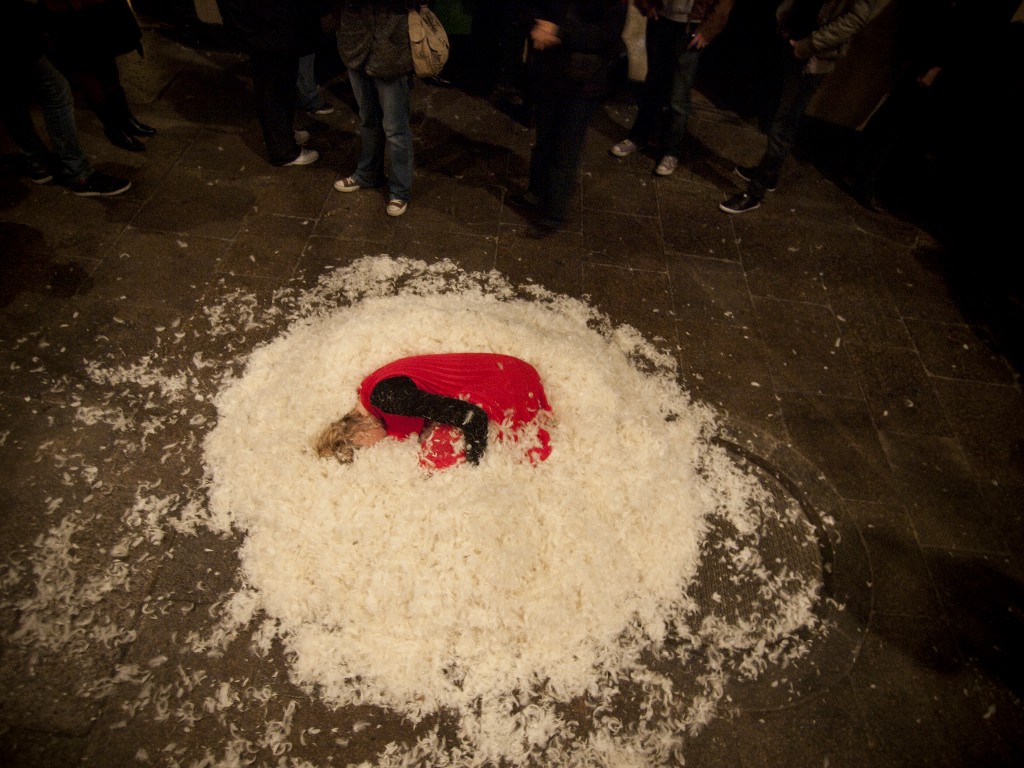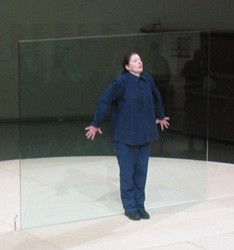'Performance Art' as Pejorative
Why do we use the term to deride social and political moments we don’t understand?

A couple of weeks ago, a friend posted on Facebook: “Plot twist: Donald Trump is a performance art piece created and operated by Hillary Clinton in order to deliver her directly into the sweet, sweet embrace of the White House.” Though it was a somewhat witty statement about the presidential race, I found myself rolling my eyes at yet another recourse to performance art as a method to explain the ridiculous and inexplicable persona of Donald Trump. When did ‘performance art’ become a point of pejorative comparison?
The point seems to be: he is ridiculous. Or, is it that performance art is ridiculous? Both performance art and Donald Trump are so unfalteringly ludicrous that we clearly have no other way to understand them other than to deride and ridicule their apparent absurdity. Of course, Hillary Clinton is a cool albeit somewhat kitsch piece of politically relevant installation art at the Venice Biennale, but the metaphor for Donald Trump is a naked, solipsistic, blood-smeared performance art piece taking place in your mate’s garage with two lonely audience members. Like Trump, performance art takes itself too seriously. It is ridiculous and over-indulgent, so we must make it a joke in order to subsume or placate this horrific otherness.
Performance art is as historically and culturally bound as sculpture, painting and film. There isn’t room in this article to cover the extensive, fascinating and important history of performance art (if someone wants to pay me to cover this in a sleek coffee table book, you know where to find me!), but here’s a gloss: performance art has its roots in the 1960s and ’70s as a specific turn away from institutionalized parameters. Many critics, curators and historians see the roots of performance as stemming from Viennese Actionism movements in Germany and Europe, while others track its origins to Dada, Surrealism and even the Greeks; the medium’s heritage is complex and manifold.
By comparing performance art and Donald Trump, we also toss performance art aside like an imperfect pebble at the beach; it’s a cultural, medium-specific scapegoat. We put a lot of pressure on performance art to read a certain way — as ridiculous and absurd (and often ensure it is culturally coded as unreadable). Yet, when performance art does read as unreadable, we hate it. From Kanye West’s Twitter outbursts to the below-average performances of football players, why then has performance art become a Trojan Horse for the inexplicable in society?

While it has become a catchall phrase, ‘performance art’ is also a pejorative metaphor — we use it to describe nefarious and inexplicable social, political and historical moments. Arguably, performance art has often wanted to remain somewhat obscure to the general public, so as not to become a commodity in the hands of the object-desperate art world. However, this has also ensured that performance art is seemingly beyond the understanding of your average member of the general populace. According to Tate curator Fiontán Moran, “If you think of the wonderful (I think) but cringe-worthy performance art segment in She’s All That, there seems to be a misunderstanding of performance as something indulgent, pretentious — akin to bad theatre.”
It’s a fine line, however; performance art is often seen as hammy and overblown. In an article for the New Statesman titled, “What if Donald Trump was actually an elaborate piece of British performance art?” Eleanor Margolis takes the premise that Trump’s presidential bid is ‘fake’ and by proxy, performance art is rendered as a bogus form. Performance art is a guise that hides the true nefarious meaning of something else — it is all pretend and we don’t need to be worried about the actual, real backbone: “either the ‘US presidential hopeful’ is Tilda Swinton in a very convincing skin suit, or we’re all doomed.” Is it simply easier to turn Trump’s completely unexpected popularity into performance art because by doing so, we don’t have to understand that this nauseating turn of events is real?
Similarly to Donald Trump, performance art is often seen as a joke that most people aren’t in on. But not “getting” performance art is what makes it a joke. Dominic Johnson, a senior lecturer at Queen Mary University in London, performance critic and artist, said that “some performance artists do ask for pejorative laughter, on account of not being scared of looking silly, non-serious or eccentric.” Trump asks for laughter (we need only to think of Trump lambasting Hillary Clinton for a ‘disgusting’ toilet break during a Democratic debate) because he is entirely serious about his seeming silliness. “Performance art is a parochial or obscure form, and it’s easier to laugh at something than stop and think about it,” he said.
I was met with a resounding ‘Ah yes’ when I asked curators, artists, performance historians and critics about the performance-art prejudice. According to historian Professor Alan Read at King’s College London, “Performance art’s own turbulent relationship with snide is long running and multifarious.” Indeed, the ‘peculiar’ is often what we mean when we use performance art as pejorative metaphor. “I think it is the way [performance art has] become a shifting signifier for all that is, supposedly, difficult, obscure, elitist, strange, queer, marginal, adversarial,” he said. Are we also using performance art as a conduit to dismiss the queer and marginal, or as Johnson rightly terms it, “that which departs from convention?”
In the early modern period in England, a large portion of anti-theatrical rhetoric stemmed from its divergence from ‘truth’; this was acting and not real behaviour. Anti-theatricalists hated the idea of men dressing up as women and vice versa — they disdained the lies and ultimately, the queer strangeness of the theater. Calling Trump performance art ensures his racist, sexist, homophobic and insidious antics are inoculated, wrongly perceived as ridiculous. Doing so turns a blind eye to performance art’s potential to employ and empower the queer, marginal and radical (which it has a long, wonderful history of doing). Dominic Johnson signed off his last email to me with the following: “Performance art is serious, even when it is not.”

In an episode of Sex and the City, Carrie and Charlotte visit a gallery performance — a spoof of Abramović’s The House with the Ocean View (2002). An Abramović look-a-like is installed for twelve days, and Carrie mentions that the artist “needs to move a comb through her hair — she has company.” Charlotte erupts with laughter and another audience member (with a shaved head, obviously) sends them a death stare. Later, when The Russian, Aleksandr Petrovsky, asks Carrie what she thought of the piece, she replies, “there are depressed women all over the city doing the exact same thing as her and not calling it art. Put a phone up on that platform and it’s just a typical Friday night waiting for some guy to call. Why do you think she has the knife ladders — to keep her from running out for a snack?” Carrie’s line is humorous in the context of Sex and the City, but not eating for twelve days straight is a colossal feat of endurance. It also parodies a real performance that was spiritual, transformative and crucial to the history of contemporary art.
I distinctly remember the first time I watched a documentary about Abramović’s work Seven Easy Pieces in an undergraduate class at King’s College London. Abramović recreates five famous performance art pieces, as well as two of her own performances. The work is terrifying, exhausting and uncomfortable to watch. Recreating Bruce Nauman’s 1972 performance Body Pressure, Abramović slams herself against a pane of glass. She squashes her body and grunts gutturally, her face transmogrifying as she presses herself against the transparent surface, the sound of her skin against the glass creating loud reverberations around the room.

I sniggered quietly to my friend as Abramović made absurd faces like a small child might do in a mirror. It seemed obvious why this work could be so easily ridiculed — how it could become fodder for a TV show. However, as I continued to watch the performance I realized that yes, perhaps I could laugh at this work, but to ignore its visceral, bodily pain would dismiss the difficulty and intended unease of this work. That my reactions were torn and confused was premeditated by Abramović — I was meant to find the work difficult to consume — laughter and pain aren’t mutually exclusive.
Not registering the discomfort, humor, and endurance of Abramović’s performances would deny the importance of this work. Though it is important that we parody performance, it is crucial that we legitimize performance as serious, even when it is not. Before we crack a joke, we should instead embrace our difficulty with performance art and learn to understand it a bit more. (Surely, making jokes without understanding and consideration is simply ignorance?) Performance art often laughs at itself, but this doesn’t mean we should automatically discredit performance art by laughing back; sometimes we need to take it seriously.
Performance art seems to have become shorthand for the obnoxious, but it is worth defending, for the precise reason that it departs from convention. It is crucial that we resist deriding a form that historically predicates and gives voice to the queer, antagonistic, peripheral, complex and radical (For example, seminal pieces such as Franko B’s I Miss You, Carolee Schneemann’s Interior Scroll, Atsuko Tanaka’s Electric Dress, Barbara T. Smith’s Ritual Meat and Yoko Ono’s Cut Piece). Let’s stopping mocking the difficult, or that which challenges us, by subsuming the ‘strange’ with pejorative laughter — let’s take the threat of Trump seriously and let’s give performance art some credit.
Bryony White is a writer based in London, UK. She has written for The Quietus, Apollo, Bust Magazine and Google Arts and Culture.
